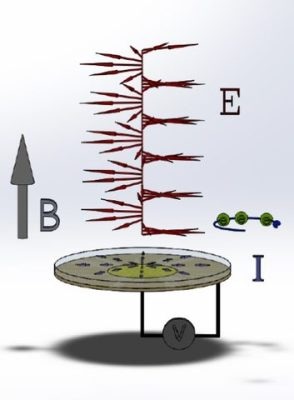Apr 11 2018
The workings of modern electronics are caused by the movement of thousands of negatively charged atomic particles called electrons. Although electrons are ubiquitous, the particulars of their behavior continue to puzzle physicists. In particular, one phenomenon that has been puzzling is the movement of electrons under the effect of polarized electromagnetic waves.
 Schematic representation of the experiment. A rotating microwave field (E) is sent through a circular layer of electrons while their electrical current (I) is measured by applying voltage (V). (Image credit: OIST)
Schematic representation of the experiment. A rotating microwave field (E) is sent through a circular layer of electrons while their electrical current (I) is measured by applying voltage (V). (Image credit: OIST)
When waves such as light waves or electromagnetic waves rotate, it results in polarization. Known as microwaves, electromagnetic fields have a rotating electric field that rotates either clockwise or counter-clockwise, and there are many concepts that predict that microwaves will impact the electron spin. However, experimental studies have demonstrated that microwave polarization does not seem to have an effect on elections. As a result, physicists continue to be puzzled by such theory-defying results.
At the Okinawa Institute of Science and Technology Graduate University (OIST), researchers performed a new study that could possibly explain this difference. In the study, the OIST team determined the electrical current across a two-dimensional (2D) plane. The researchers changed the polarization of microwaves to demonstrate that polarization does affect the motion of electrons. The results of their study were reported in Physical Review Letters.
“It is natural to expect that the effect will be strongest when both electrons and microwave fields rotate in the same direction, and will be strongly reduced when the directions of their rotation is opposite,” said Denis Konstantinov, head of OIST’s Quantum Dynamics Unit and senior author on that paper. That is certainly what Konstantinov and his team members discovered.
For the study, the OIST team teamed up with scientists at the Institute of Low-Temperature Physics and Engineering in Ukraine. While a Ukraine-based coworker came up with a mathematical framework to test the prominent theories within the scientists’ framework, OIST researchers verified them experimentally.
In earlier experiments, the movement of the electrons was studied in solid-state materials, for example, semiconductors. However, these materials contain impurities that cannot be removed and thus can affect the results. Therefore, the scientists eventually developed a system that uses liquid helium to closely simulate the function of a semiconductor.
This system contains electrons on the surface of liquid helium, which is contained in a vacuum chamber and cooled to almost absolute zero temperatures —about -273 °C.
“Nothing is ideal in a solid state,” said Konstantinov. “That’s why our system is nice—now we can eliminate all these impurities and defects.”
One unique quality of helium is that it continues to be in liquid state, even in temperatures that reach absolute zero. In the interim, any other compounds (impurities inside the helium) will freeze and cling to its container walls. At such extremely low temperature, the electrons present at the surface of the helium become “quantized”—the electrons’ motion perpendicular to the liquid is “frozen out” into a 2D space, informed Konstantinov.
In the newly developed system, the research team sent circular-polarized microwaves down through this electron layer and then made the electrons to rotate in the direction same as the rotation of microwave field. Following which, the measured current of electrons began to oscillate with the applied magnetic field. The researchers then switched the direction of the magnetic field to reverse the rotation of electrons and observed that the oscillation weakened considerably. They observed the same behavior after they reversed the direction of the rotation of the microwave field without changing the rotation of electrons.
This implies that polarization of these electromagnetic waves indeed affect electrons. However, more research needs to be done to understand the behavior of these particles, said Oleksiy Zadorozhko, a postdoctoral researcher at OIST and first author of the paper
“At the moment we can’t yet point to which of the many theories is the primary one,” he said. “Our next step is a more detailed study of this.”